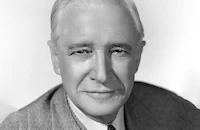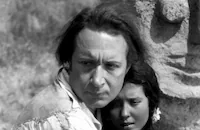Escape in the Desert

Brief Synopsis
Cast & Crew
Edward A. Blatt
Jean Sullivan
Philip Dorn
Irene Manning
Helmut Dantine
Alan Hale
Film Details
Technical Specs

Synopsis
While on a mission to destroy a Japanese oil refinery, pilot Phillip Artveld remembers his first visit to the United States in 1944: After his country, the Netherlands, is liberated, Phillip volunteers to fight in the Pacific. In order to see some of the country, he decides to hitchhike to San Francisco, from where he will leave for the East. Meanwhile, four Nazi prisoners of war escape into the California desert. Although motorists are warned not to pick up hitchhikers, Phillip gets a ride from Gramp, the owner of the Land's End motel and gas station near Death Valley. When Phillip makes a statement in German, Gramp concludes that he is one of the escaped prisoners and takes him into custody at gunpoint. Waiting at the motel are Gramp's beautiful granddaughter Jane, her younger brother Danny and station attendant Hank Albright, who is in love with Jane. Hank summons the sheriff, but Jane quickly discovers Phillip's real identity, and overjoyed at finding someone who shares her interest in painting and literature, begs him to take her to San Francisco. Realizing that Jane would leave with any man who would take her, Phillip replies that he will travel on alone. Nonetheless, Jane kisses Phillip and is seen by Hank, who jealously picks a fight with Phillip. Phillip then walks back up the road to wait for a ride. He is picked up by the escaped Nazis, who have already killed several people for their clothes and cars. When they learn about the motel, the Nazis return there, hoping to acquire guns. Captain Becker, the leader of the Nazis, plans to kill the men and take Jane as a hostage, but his plans are interrupted by the arrival of the sheriff, who is responding to Hank's earlier summons. Becker pretends to be Phillip, and Jane goes along with his charade to protect the others. Later, tourists Dr. Orville Tedder, a dentist, and his wife Lora stop at the motel, and Becker takes them prisoner in order to steal their car. His plans are thwarted, however, because the car is not full of gas, and the Nazis must wait for the midnight gas delivery. When the truck approaches, Jane calls out a warning, but the Nazis shoot the driver. After they fill up the tank of the car and drive off, the car crashes and explodes. Although all the Nazis manage to escape, the explosion attracts the attention of the sheriff, and a gunfight ensues. Becker tells Phillip, who is outside with the sheriff's men, that he will kill his hostages unless he and his men are allowed to go free. In order to prevent this, Phillip throws a dynamite fuse into the room and, mistaking it for a bomb, the Nazis run outside and are captured.

Director
Edward A. Blatt
Cast
Jean Sullivan

Philip Dorn

Irene Manning

Helmut Dantine

Alan Hale

Samuel S. Hinds
Bill Kennedy

Kurt Kreuger
Rudolph Anders
Hans Schumm
Blaney Lewis
Selmer Jackson
Oliver Prickett

Angela Greene
Victor Killian
Tom Fadden
Charles Cane

Monte Blue
James Notaro

Jack Mower
Cliff Clark
Trevor Bardette
Alan Bridge
George Sherwood
Crew
Milo Anderson
Marvin Borowsky
Robert Burks
Gordon M. Davis
Paul Detlefsen
Adolph Deutsch
Leo F. Forbstein
Charles David Forrest
Alex Gottlieb
Jesse Hibbs
John Hughes
Thomas Job
Bill Kissel
Charles Lang
Vernon Larson
Owen Marks
E. Kenneth Martin
Jerome Moross
Clarence Steenson
Willard Van Enger
Jack L. Warner
Perc Westmore

Film Details
Technical Specs

Articles
Escape in the Desert
By Glenn Erickson

Escape in the Desert
Quotes
Trivia
Notes
The film's working titles were Strangers in Our Midst and Men Without Destiny. According to an undated press release, the film was originally to star Paul Lukas and Geraldine Fitzgerald. A May 10, 1944 press release announced Zachary Scott as the male lead. On June 18, 1944, a New York Times news item reported that Lukas had been suspended for turning down the role, and Scott was unable to play the part because of illness. The same article notes that the film's desert setting was built on a studio sound stage. Robert Sherwood's play was also the basis for the 1936 Warner Bros. film The Petrified Forest, which starred Bette Davis and Leslie Howard and was directed by Archie Mayo (see AFI Catalog of Feature Films, 1931-40; F3.3433). A television version of the play starring Humphrey Bogart and Lauren Bacall was made in 1955.















